
Blackfishing on social media
The new social media trend of 'blackfishing' has shocked many users on Twitter (Zoellner, 2018). Blackfishing refers to the phenomenon whereby white women alter their appearance to such an extent that they appear to be biracial or black. Blackfishing shows how group boundaries defining insiders and outsiders are established. In this context, individuals accused of blackfishing are labeled as deviant, as outsiders, since they do not belong to the black community.
This article aims to analyze the phenomenon of blackfishing to understand why and how young white women would want to alter their appearance from looking white to appearing black, or at least to embodying "black emblems", like dark skin and curly hair. More specifically, the article aims at understanding this social identity issue and the creation of this deviant group in relation to fashion culture and the emergence of micro-celebrities.
The rise of blackfishing
The term blackfishing describes white women "posing as a light-skin black or biracial person" (Zoellner, 2018). Debates on the issue started on the social media platform Twitter, when Instagram model and influencer Emma Hallberg was exposed for allegedly altering her appearance and "posing as a biracial woman to gain a larger following" (Zoellner, 2018). According to the Daily Mail, Hallberg’s behavior shocked thousands of Twitter users, sparking a debate as to whether this constituted a case of ‘cultural appropriation’ (Blatchford, 2017) and whether it could even be considered ‘blackface’ (Nova, 2018).
The Twitter debate raised the question where the line between authenticity and cultural appropriation should be drawn. It included a reference to former civil rights activist Rachel Dolezal's famous statement, “I identify as black” - even though she actually is of white European descent (BBC, 2015).
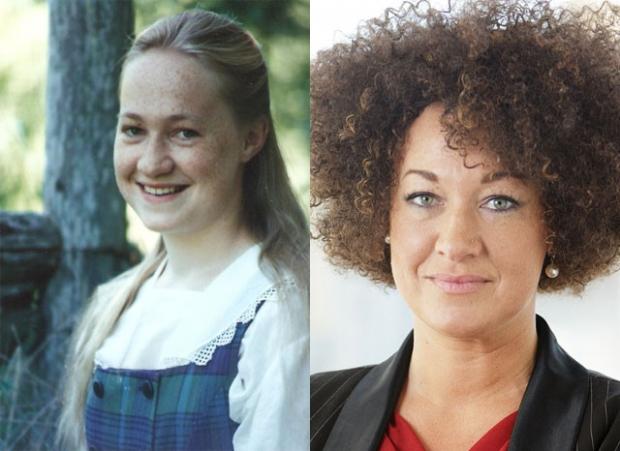
Rachel Dolezal compared to her past
In order to understand blackfishing, let us briefly turn to sociologist Erving Goffman's approach to people's presentation of identity in everyday life. Goffman looks at identity by focusing on "everyday, small-scale social engagements between people" (Branaman, 1997). According to Goffman, identity "comes about" through social interaction. In interactions, people stage an act and assume "roles" that create impressions favored by the crowd. In other words, we will understand identity if we can find out the different roles a person plays on the "front stage" (for example, in front of an online or offline audience) and the "back stage" (for example, in one's private space at home).
The front stage and back stage of one's life include certain "scripts" that define the situations in which they enact their various identity performances. Scripts, according to Goffman, are guidelines or regulations that govern people's behavior in relation to the present situation. As a consequence, in Goffman's view, identity is "not some innate quality, nor physically localizable property" but "the socially constructed result of all our engagements with others" (Branaman, 1997).
White is the new black
In order to understand why the appropriation of black identity is so controversial, we must look at hair and cultural identity within the Black community for context. In the past, black women were forced to hide their hair with headscarves in order to make themselves less attractive to their masters (Williams, n.d.).
Nowadays, there are still black women who are forced to adapt their hairstyles: “in certain places, industries, or workplaces, traditionally Black hairstyles [...] are restricted and can be cause for termination”. When a person conceals or displays their race through their appearance, it is important to know and understand the different historic contexts and thought processes that might impact the meanings and interpretations of these acts.
Blackfishing as an identity issue
Keeping in mind Goffman's approach to identity and the above-described history, we need to look at blackfishing as an identity issue and thus as a social phenomenon. One group of "white people" is presenting indexes of "black culture" or blackness, and in doing so follows certain behavioral scripts. So, what are the indexicalities of these scripts through which they identify themselves and are identified by others?
Blackness is defined not only in cultural, but also in biological terms. More specifically, the scripted cosmetic alterations concern white women altering their skin color to a darker tone, and fashionably styling themselves in line with black or biracial fashion gurus.
Blackness is defined not only in cultural, but also in biological terms.
Of course, the alterations do not stop with skin color. There is a mainstream trend which includes getting lip fillers to appear more biracial. Also, one's hair is usually fitted with extensions to create more volume. Make up is applied three to five shades darker than the actual skin tone. These are only some among many more alterations that white women individually apply to appear more black or biracial. After the alternations, users mostly post their look or style on front stage social media like Instagram.
On the other hand, at home, i.e. back stage, these women remain white and keep their white identity. Below is the example of Hallberg who has been accused of blackfishing due to pictures she posted on Instagram (Hensley, 2018).
black3.jpg

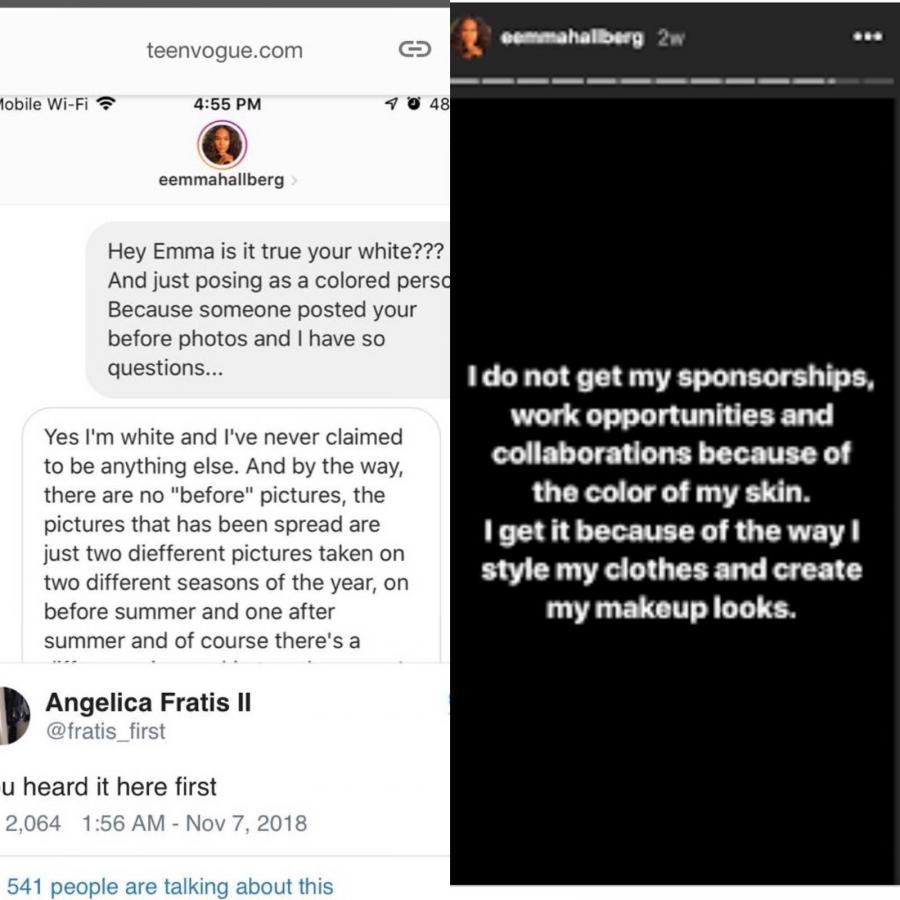
Emma Hallberg exposed
The case of Emma Hallberg
Hallberg has spoken out against the accusations made against her. As can be seen in the video below, she says that these are "just two different pictures taken in two different seasons of the year". She also denies having done anything to make her skin look darker, explaining that she gets "a deep tan" from the sun and that this is all "natural".
On the opposing side, we find Twitter users that were not convinced by Hallberg's video. In the picture below, Hallberg's usual make-up is displayed. A similar picture surfaced on the internet, on which one Twitter user commented that it looked as if she was "appropriating black features". Another user pointed out that "Emma Hallberg is not black" (mentioned in the video). This clearly indicates people draw a line between being black and identifying as black, and therefore between an ingroup and an outgroup.
In sociologist Howard Becker's terms, these people are “crusaders” (1967), people that set up boundaries. These boundaries help identify who is an insider and who is an outsider and is thus constructed and labelled as a deviant. The boundaries are fixed: insiders are black or biracial girls. Outsiders or deviants are women who are only appearing to be black, e.g. a person like Hallberg.
Emma Hallberg Make up Routine 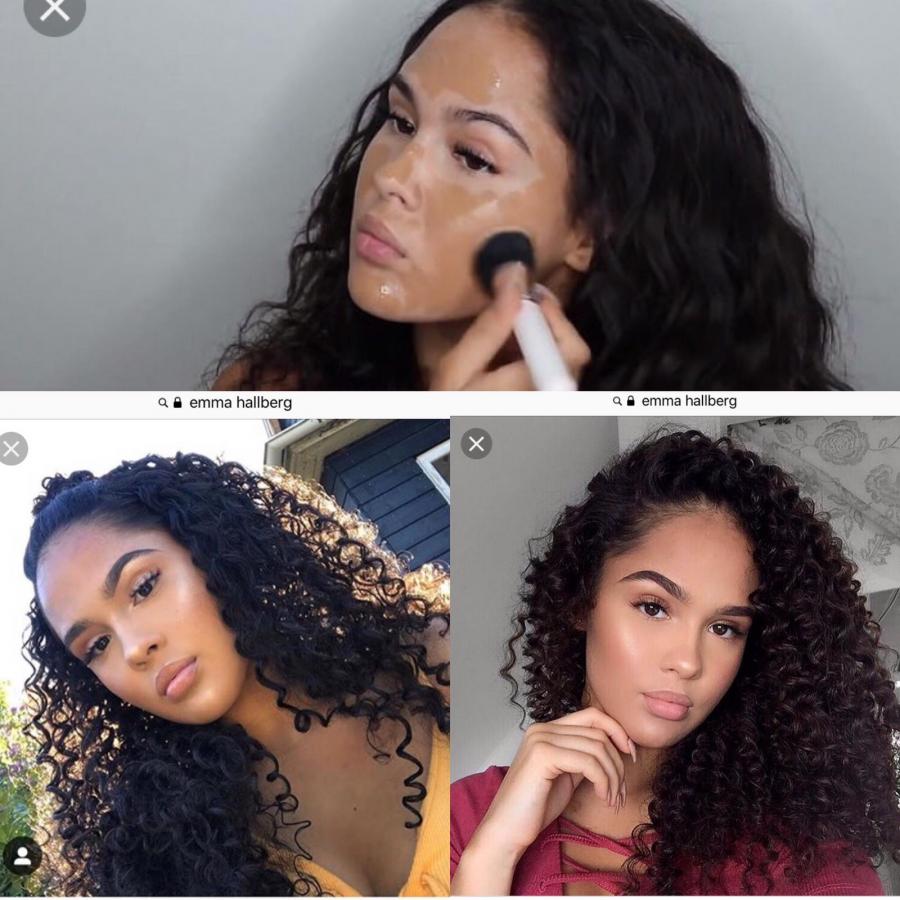
Thus, if a person appears black in this specific way, she should not be considered black as the boundaries between black and non-black are clearly established. According to the crusaders, this person is therefore blackfishing.
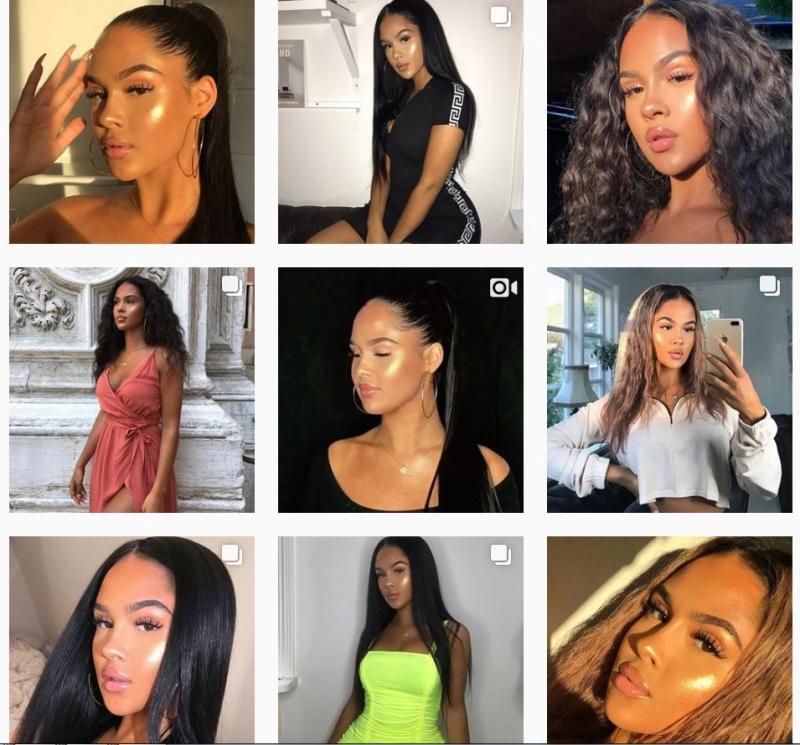
Emma Hallberg posing
The pictures above clearly show Hallberg with a deep tan, full lips, and curly hair, despite being white. Considering Hallberg’s social reach — she has over half a million followers on Instagram —, her behavior might encourage young women like her to go through a process of altering their appearance too. Social media celebrities like Hallberg clearly orient themselves to "black culture" in their public performance of identity.
At the same time, Hallberg has said she is "sad" for being accused of intentionally misleading her followers, especially since it's her "natural features [that are] hurting and upsetting people". Even though she does not explicitly claim a "black identity", her style is read as "black" and her identity performance is therefore read as blackfishing and cultural appropriation.
In other words, organizing all the identity emblems of a black social media celebrity on one's person is not enough to be considered black. In these Twitter raids, blackness is defined not only in cultural, but also in biological terms: Hallberg is not biologically black and will never be black by altering her appearance only. She will always remain a "deviant outsider".
White is the new black
Today, the queen of fashion culture is none other than Kim Kardashian (Team Emirates Woman, 2015). Kardashian has been accused numerous times of cultural appropriation and the use of whitewashing to make black things appear more fashionable. The following quote explains the exact issue with this trend, which was fueled by the Kardashians:
"Cultural appropriation, whitewashing, and stereotyping is still prevalent in a supposedly post-racist society, most likely due to ignorance and media portrayals. In America, the stereotype specifically for black people is "ghetto", uneducated, poor, dark, unkept short hair and "inappropriate" clothing and listening to extremely loud rap/hip-hop, but when white people discover something about black culture they take it, and it becomes "trendy" without offering where it comes from, nor without [sic] bothering with the historical context or situational context."
Pictured below is Kardashian in a revealing Instagram selfie wearing cornrows. The controversy started when she titled the post “Bo West”. The title alluded to actress Bo Derek and her braids in the famous 1979 movie 10. A lot of Instagram followers were furious (Gray, 2018) because Kim gave credit to a white woman for this styling even though this is a historically traditional black hairstyle (FASHION Staff, 2018).
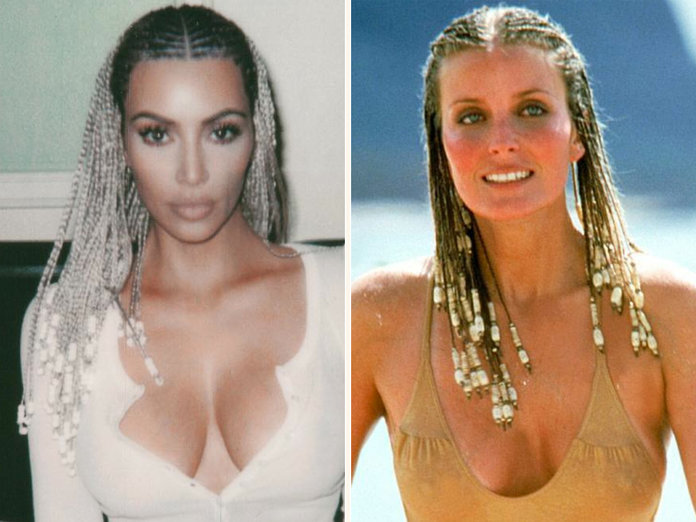
Kim Kardashian and Bo Derek wearing cornrows
This is cultural appropriation. It is taking something from another culture and making it your own, without giving credit to its creators (BBC Stories, 2018). In this particular case, Kardashian took something central to the black community and stamped her white name on it. Taking into account Kardashian’s online presence, we might imagine Hallberg as a young woman who is highly influenced by fashion and, more specifically, by the actions of Kardashian and other famous trendsetters. If her idol can do it, why wouldn't Hallberg and her followers do it as well? From this perspective, Hallberg has appropriated a style associated with biracial or black girls to keep up with the culture of fashion trends.
Blackfishing and the Web 2.0
This is dubbed the "Kylie Jenner effect", which refers to girls following the example of beauty entrepreneur Kylie Jenner in considering artificial interventions to one's appearance as "normal" (Musariri, 2018). With the rise of Web 2.0, social media has "democratized" the concept of celebrity and a new type of "micro-celebrities" has emerged (Giles, 2018). Kardashian, Jenner and Hallberg are celebrities, people that as "an individual rise above the rest of the population" and "pose an imagination of self upon them". Hallberg is considered a micro-celebrity, whereas Kardashian and Jenner are not. Their influence on the public and their needs to manage their identities, however, are similar. Because of their online reach they have a massive amount of ground to consciously or unconsciously influence and manipulate their followers to engage in blackfishing. More girls and young women might want to look black regardless of their inherent white features.
They only want the looks, not the identity, lifestyle or problems that come with being black.
However, they only want the looks, not the identity, lifestyle or problems that come with being black. This explains why the term blackfishing is derived from catfishing. Catfishing refers to a person posing as someone else on the Internet (Harris, 2013). Blackfishing in turn is about a white person posing as a black person. The similarity between the two is in the fact that both create fake, appearance-only identities.
Concluding: merely appearing black
Looking at the behavior of other celebrities and considering the effects of social media, Hallberg is not the only one engaging in drastic changes in appearance that are considered part of ‘blackfishing’. There are many more women who have done and do the same, which demonstrates we are dealing with a larger social phenomenon. Are women that appropriate "black emblems" inauthentic, and should their behavior be seen as problematic? Or are they merely following popular fashion culture and responding to the influences of social media?
Using the work of Goffman and Becker, this analysis has examined the establishment of a new deviant outsider group that is trying to imitate a "black image". This front stage performance of identity features can be seen as a form of cultural appropriation. A few white celebrities, micro-celebrities and their followers want to appear black; but only in the form of looks, hairdo, clothing style, and a few body and facial features — making it an extensive fashion style. Back stage, they want to retain their white identities, and not live with the problems and injustices that come with being black.
References
BBC. (2015, 16 juni). Race activist Rachel Dolezal: “I identify as black”. BBC News.
BBC Stories. (2018, 15 september). Cultural Appropriation: Whose problem is it? BBC Stories. YouTube.
Becker, H. S. (1967). Other side: Perspectives on deviance. New York:The Free Press.
Branaman, A. (1997). Goffman's social theory. InC.C. Lemert & A. Branaman (Eds.) The Goffman reader (pp. xlv-lxxxii). Cambridge, MA: Blackwell.
FASHION staff. (2018, January 30). Sorry Kim Kardashian, But Cornrows Aren’t “Bo Derek Braids”. FASHION. Fashionmagazine.com.
Giles, D. C. (2018). Twenty-First Century Celebrity. Van Haren Publishing.
Gray, D. (2018, 29 januari). Kim Kardashian Slammed for Calling Cornrows “Bo Derek Braids”. Allure. Geraadpleegd op 2 juni 2022, van
Harris, A. (2013, 18 januari). Who Coined the Term “Catfish”? Slate Magazine.
Hensley, L. (2018, November 27). ‘Blackfishing’: A problematic trend where people pretend to be black. Global News. globalnews.ca.
Musariri, D. (2018, 12 november). White women are posing as black on Instagram. Are the Kardashians to blame? New Statesman.
Nova, A. (2018, 9 januari). BLACKFACE ON YOUTUBE AND INSTAGRAM | Annie Nova. YouTube. Geraadpleegd op 2 juni 2022, van
Team Emirates Woman. (2015, 21 oktober). Keeping Up With The Books: How Kim Kardashian Became a Business Queen. Emirates Woman.
Williams, A. (n.d.) The connection between hair and identity in black culture. C+R Research. Crresearch.com.
Zoellner, D. (2018, November 16). The rise of 'Blackfishing': Twitter users furiously call out white influencers who they claim are 'posing' as biracial women in order to gain more followers. The Daily Mail. dailymail.co.uk.